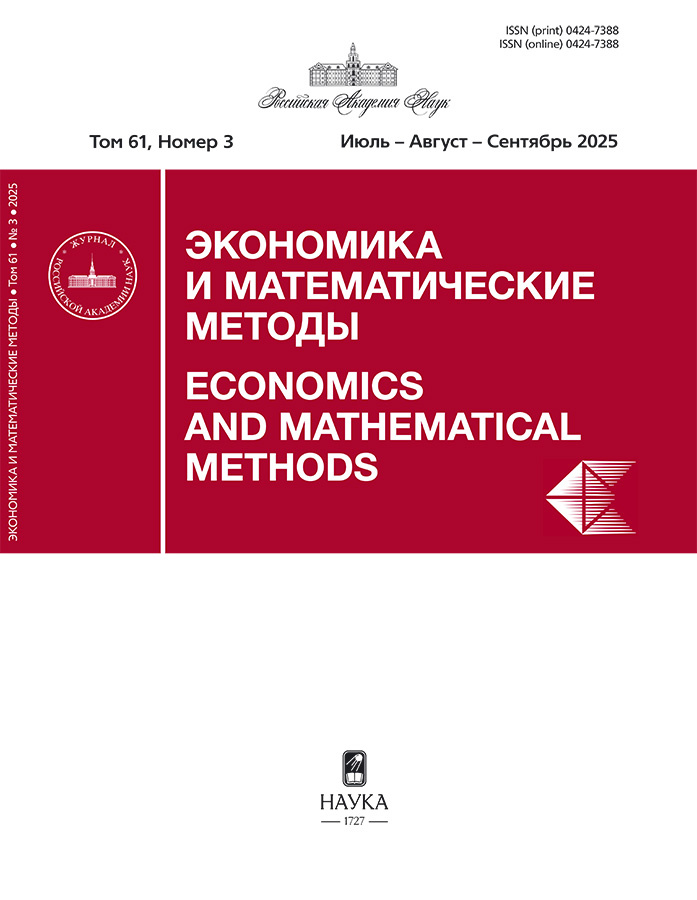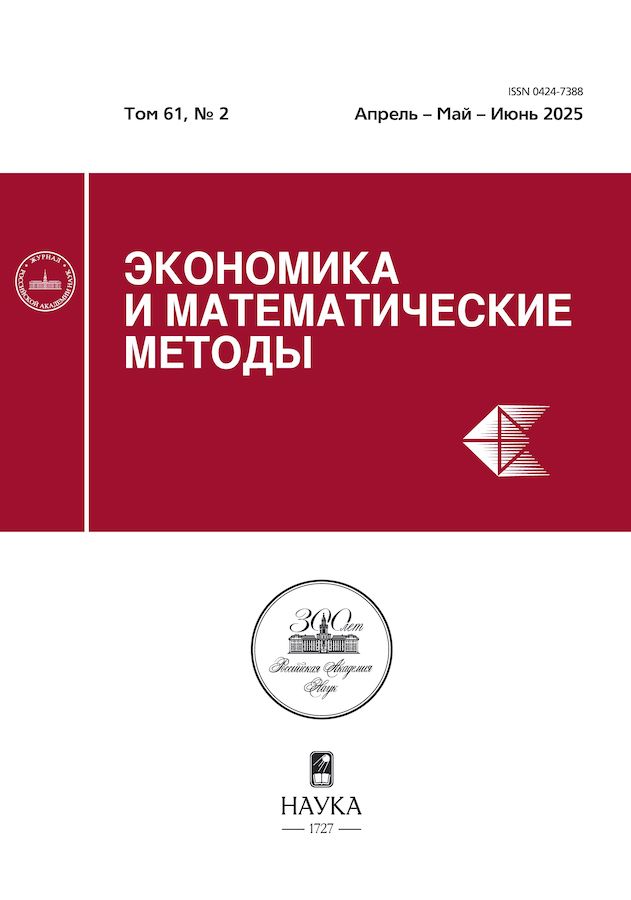Использование квазиэкспериментальных методов для количественного анализа эффективности гарантийной программы поддержки МСП
- Авторы: Белоглазов А.Д.1,2, Манахова И.В.2,3, Халтурин К.Ю.1
-
Учреждения:
- Фонд «Институт экономической политики имени Е. Т. Гайдара»
- МГУ имени М. В. Ломоносова
- РУДН имени Патриса Лумумбы
- Выпуск: Том 61, № 2 (2025)
- Страницы: 104-117
- Раздел: Проблемы предприятий
- URL: https://transsyst.ru/0424-7388/article/view/684534
- DOI: https://doi.org/10.31857/S0424738825020088
- ID: 684534
Цитировать
Полный текст
Аннотация
В работе продемонстрированы возможности использования квазиэкспериментальных методов для получения количественной оценки чистого эффекта отдельных мер государственной политики на примере программы предоставления банковских гарантий для субъектов МСП (малого и среднего предпринимательства). В качестве целевой метрики рассматривается занятость в субъектах МСП — показатель, увеличение которого до 25 млн человек зафиксировано в национальной цели «Достойный, эффективный труд и успешное предпринимательство». В рамках исследования предлагаются методы соответствия оценок склонности PSM, которые могут быть применены для получения оценки эффективности действия конкретной государственной меры. Данные методы, наряду с двухступенчатой регрессией Хекмана и моделями панельных данных для многопериодного расширения Difference-in-Difference, представляются наиболее подходящими для оценки эффекта вмешательства и снижения ошибки выборки. Полученные на основе данной методологии оценки свидетельствуют о значимом положительном эффекте выдачи гарантий в терминах увеличения занятости. Также выделены отрасли и регионы с наибольшим положительным эффектом от меры. Сделан вывод, что для мер государственной политики, эффективность которых подтверждена количественно, необходимы действия, направленные на рост охвата целевой аудитории.
Полный текст
Об авторах
А. Д. Белоглазов
Фонд «Институт экономической политики имени Е. Т. Гайдара»; МГУ имени М. В. Ломоносова
Автор, ответственный за переписку.
Email: beloglazov@iep.ru
Россия, Москва; Москва
И. В. Манахова
МГУ имени М. В. Ломоносова; РУДН имени Патриса Лумумбы
Email: ManakhovaIV@mail.ru
Россия, Москва; Москва
К. Ю. Халтурин
Фонд «Институт экономической политики имени Е. Т. Гайдара»
Email: khalturin@iep.ru
Россия, Москва
Список литературы
- Аганбегян А. Г. (2023a). Инновации в России: от высокого знания и наличия перспективных научных заделов к эффективному социально-экономическому развитию // Экономическое возрождение России. № 2 (76). С. 13–26. doi: 10.37930/1990-9780-2023-2 (76)-13-26 [Aganbegyan A. G. (2023a). Innovations in Russia: From possessing the higher knowledge and promising scientific groundwork towards effective socio-economic development. Economic Revival of Russia, 2 (76), 13–26. doi: 10.37930/1990-9780-2023-2 (76)-13-26 (in Russian).]
- Аганбегян А. Г. (2023б). «Кремниевые долины» — зоны инноваций в США, Китае, ЕС, России и других странах // Экономика науки. № 9 (2). С. 8–19. doi: 10.22394/2410-132X-2023-9-2-8-19 [Aganbegyan A. G. (2023b). “Silicon Valleys” — innovation zones in the USA, China, EU, Russia, and other countries. Economics of Science, 9 (2), 8–19. doi: 10.22394/2410-132X-2023-9-2-8-19 (in Russian).]
- Дементьев В. Е. (2023). Обновление технологической базы производства и процентная ставка // Экономическое возрождение России. № 2 (76). С. 70–83. doi: 10.37930/1990-9780-2023-2(76)-70-83 [Dementiev V. E. (2023). Updating the technological foundation of production and percentage policy. Economic Revival of Russia, 2 (76), 70–83. doi: 10.37930/1990-9780-2023-2(76)-70-83 (in Russian).]
- Казанцев К. И., Румянцева А. Е. (2020). От избрания к назначению. Оценка эффекта смены модели управления муниципалитетами в России. М.: ЦПУР. Режим доступа: https://cpur.ru/new-research/r_local_government_from_election_to_appointment. [Kazantsev K. I., Rumyantseva A. E. (2020). From electing to appointment: Effect of changing the model of municipalities governance in Russia. Moscow: Center for advanced governance. Available at: https://cpur.ru/new-research/r_local_government_from_election_to_appointment (in Russian).]
- Манахова И. В., Белоглазов А. Д. (2023). Цифровая трансформация малого и среднего бизнеса в России: вызовы, перcпективы и роль государственной поддержки // Российский экономический журнал. № 5. С. 112– 124. doi: 10.52210/0130-9757_2023_5_112 [Manakhova I. V., Beloglazov A. D. (2023). Digital transformation of small and medium sized business in Russia: Challenges, prospects and the role of state support. Russian Economic Journal, 5, 112–124. doi: 10.52210/0130-9757_2023_5_112 (in Russian).]
- Медовников Д. С., Оганесян Т. К., Розмирович С. Д. (2016). Кандидаты в чемпионы: средние быстрорастущие компании и программы их поддержки // Вопросы экономики. № 9. С. 50–66. doi: 10.32609/0042-8736-2016-9-50-66 [Medovnikov D. S., Oganesyan T. K., Rozmirovich S. D. (2016). Сandidates for the championship: Mediumsized high growth companies and state-run programs for their support. Voprosy Economiki, 9, 50–66 (in Russian).]
- Орехова С. В., Лопатин В. М. (2022). Зомби-компании: феномен, методы индентификации и влияние на конкуренцию // Вестник Омского университета. Серия «Экономика». Т. 20. № 2. С. 47–63. doi: 10.24147/1812-3988.2022.20 (2).47-63 [Orekhova S. V., Lopatin V. M. (2022). Zombie companies: Phenomenon, identification methods and impact on competition. Herald of Omsk University. Series “Economics”, 20 (2), 47–63. doi: 10.24147/1812-3988.2022.20 (2).47-63 (in Russian).]
- Репина Е. Г., Ширяева Л. К., Федорова Е. А. (2019). Исследование зависимости между развитием малого предпринимательства и микрофинансовой обеспеченностью регионов РФ // Экономика и математические методы. Т. 55. № 2. С. 41–57. doi: 10.31857/S042473880004680-7 [Repina E. G., Shiryaeva L. K., Fedorova E. A. (2019). The Study of Dependence Structure between Small Business Development and Microfinance Security of Russian Regions. Economics and Mathematical methods, 55, 2, 41–55. doi: 10.31857/S042473880004680-7 (in Russian).]
- Asdrubali P., Signore S. (2015). The economic impact of EU guarantees on credit to SMEs — evidence from CESEE countries. EIF Working Paper Series. Luxembourg: European Investment Fund (EIF).
- Austin P. (2011). Optimal caliper widths for propensity-score matching when estimating differences in means and differences in proportions in observational studies. Pharmaceutical Statistics, Marсh–April. doi: 10.1002/pst.433
- Del Monte A., Scalera D. (2001). The life duration of small firms born within a start-up programme: Evidence from Italy. Regional Studies, 35, 1. doi: 10.1080/00343400120025646
- Flury B.K, Riedwyl H. (1986). Standard distance in univariate and multivariate analysis. The American Statistician, 40, 3, 249–251. doi: 10.1080/00031305.1986.10475403
- Khrupina K., Manakhova I., Putilov A. (2022). Developing of smart technical platforms concerning national economic security. In: V. V. Klimov, D. J. Kelley (eds.). Biologically inspired cognitive architectures 2021. BICA 2021. Conference proceeding: Studies in Computational Intelligence, 1032, 208–215. Cham.: Springer. doi: 10.1007/978-3-030-96993-6_20
- Riding A., Haines G. (2011). Loan guarantee: Cost of default and benefit to small firms. Journal of Business Venturing, 16, 6, 595–612. doi: 10.1016/S0883-9026 (00)00050-1
- Roper S., Hewitt-Dundas N. (2001). Grant assistance and small firm development in Northern Ireland and the Republic of Ireland. Scottish Journal of Political Economy, 48, 1. doi: 10.1111/1467-9485.00187
- Rosenbaum P., Rubin D. (1983). The central role of the propensity score in observational studies for causal effects. Biometrika, 70, 41–55. doi: 10.2307/2335942
Дополнительные файлы











